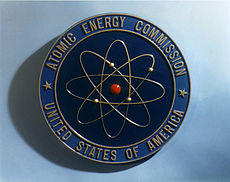In 1946 President Harry S. Truman transferred control of atomic energy development from the military to civilian control by signing the McHahon/Atomic Energy Act. This Act created the Atomic Energy Commission or AEC. Congress passed the act after extensive debate involving scientist, military men and politicians over the future of atomic energy. The mandate of the commission was to "promote world peace, improve public welfare and strengthen free competition in private enterprise."
The Act which created the AEC gave it power to regulate the entire field of nuclear science and technology. Transfer of nuclear technology between the United States and other countries was prohibited and the FBI was charged with policing access to nuclear information. The AEC was granted a great deal of power and independence with its employees being exempt from the Civil Service rules. All production facilities and nuclear reactors would be owned by the federal government while laboratories such as Argonne National Laboratory would be under the control of the AEC.
Although the AEC was charged with the development of peaceful uses of nuclear energy, most of its early work was dedicated to the development of the nuclear arsenal of the United States. The World War II Manhattan Project turned over its work to the new AEC which continued the evolution of atomic bomb as well as the development of the hydrogen bomb. The AEC oversaw two nuclear laboratories for weapons work, Los Alamos Scientific Laboratory and Lawrence Livermore National Laboratory. A project of nuclear testing was implemented in the American Southwest and an area in the Pacific Ocean.
The General Advisory Committee of the AEC provided technical and scientific advice. A Military Liaison Committed was a bridge between the AEC and the United States Military. The Congressional Joint Committee on Atomic Energy provided oversight. With its great power over all things nuclear in the United States, the AEC was the center of controversies.
The AEC was in charge of all regulation of nuclear facilities. The Atomic Energy Act Amendments of 1954 cleared the way for the development of civilian nuclear reactors to provided electricity. This act required the AEC to both promote civilian nuclear power and to insure its safety. These contradictory mandates would prove to be difficult to reconcile.
During the 1960s, critics claimed that the AEC regulations were not strong enough with regard to radiation protection, nuclear reactor safety, siting of power plants, danger to the environment and other concerns.
In the early 1970s, the construction of nuclear power plants declined due to increasing construction costs and lowering demand for electricity. Construction of some partially built plants was halted. In 1974, Congress responded to criticisms of the AEC by abolishing the agency. The Energy Reorganization Act of 1974 created two new agencies. The Energy Research and Development Administration (ERDA) was set up to promote civilian nuclear power and to oversee civilian nuclear research, nuclear weapons development and naval reactor program. The ERDA was combined with the Federal Energy Administration in 1977 to create the U.S. Department of Energy. The Nuclear Regulatory Commission was also established by the 1974 Act to regulate the nuclear industry.
With the enormous cost of nuclear power development, it was inevitable that there would be conflicts of interest in the AEC and absolutely necessary that its job be split between new agencies.
